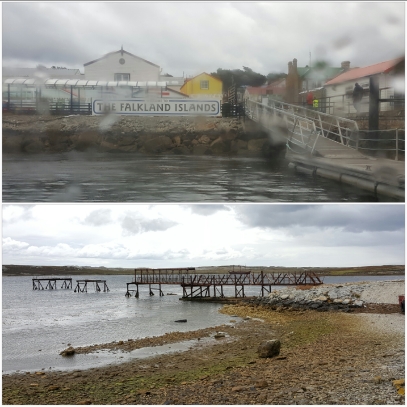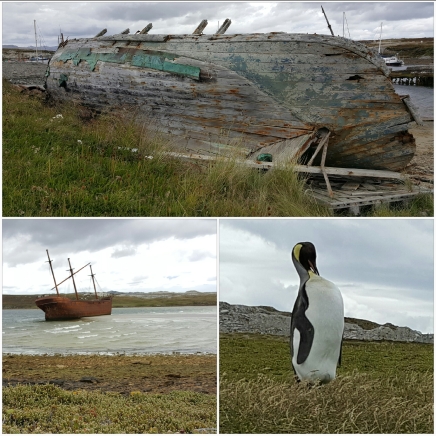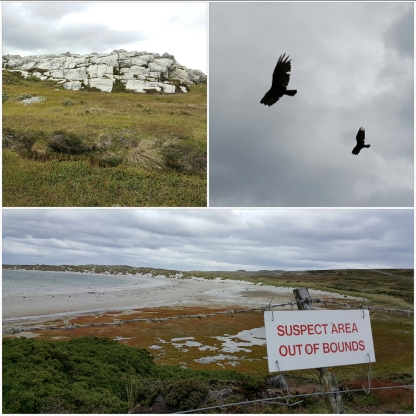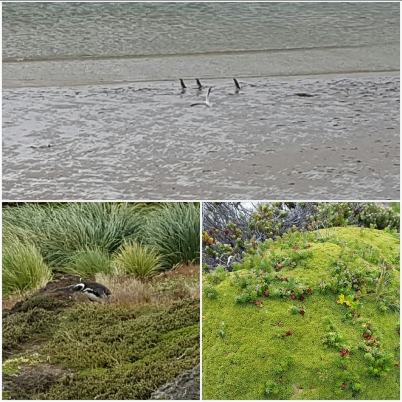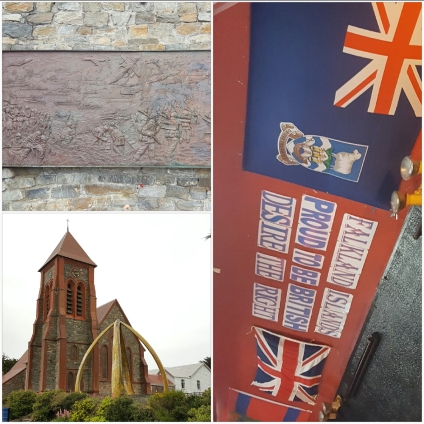Patagonia and the Falkland Islands have been on our bucket list for a while, and for some reason, a cruise seemed like a way to cover a lot of ground with minimal effort while have a few days off from cooking and the dishes. It also happened to be a way to move from Buenos Aires to Santiago. International airfare in South America is expensive; this would allow that price to be rolled up into the cruise. In the end, however, it was probably not worth the added cost, which worked out to more than 3x what we normally spend per day – despite the fact we bought the absolute cheapest ticket and spent as little money on board as possible.
We did see pretty things from the boat and get dropped off in gorgeous places, but that is the best I can say for our fifteen days on board the Norwegian Sun. I would have willingly spent more time in many of the ports, and cut out Punta del Este and Puerto Madryn. Puerto Chacobuco would be a great base for hiking, but we were in port such a short amount of time it was basically a wasted morning.
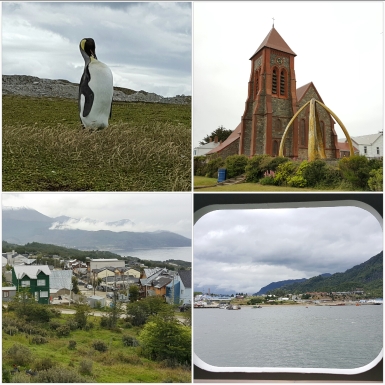
Our cabin was tiny, which I completely understand. It’s on a ship, after all. It was an interior room, meaning no windows. We tried to compensate for this utter lack of light by leaving the TV on at night and tuned to the live video feed from the front of the ship. This is a good idea in theory, but I am a light sleeper. Since the southern summer sun rises early, I’d wake at 5 a.m., as soon as the light shifted. This lasted about two days before we switched back to alarms. We did have enough space for our clothes, and the beds are sized so that luggage can disappear underneath. The woman who took care of our room was very kind, and commiserated with us on the days when we encountered larger waves and everyone was feeling a little woozy.
Unlike shorter Alaskan or Caribbean cruises, we had a total of six days at sea out of fifteen total days. We mistakenly looked forward to this as an opportunity to work. In the end it turned out the internet onboard was far too expensive for any meaningful connection (about $30/day, but only when paying for the 15-day package, so $450 total). Workspaces were few and far between when everyone else was on board and bored. Our room was too small for us to be set up comfortably, and by 9am, most public spaces on the ship were occupied by others also escaping their tiny quarters.
So maybe we take a break from work and let ourselves be entertained for those days. Turns out that the cruise didn’t really compensate for the lack of a port with extra activities on the ship. We could hang out in the casino, play poker, or attend a sales seminar – none of which appealed to us in the slightest. Trivia was the best option, which helped us amuse ourselves for about ninety minutes spread throughout the day. But after a week the questions began to repeat and it became an exercise in seeing how many we could remember correctly from earlier in the cruise (waaay too similar to fact-vomiting grade-school tests to be fun). The staff members running the few non-trivia games kept making jokes about how much better it would be if they had a budget and reminding us that there were no real prizes. But it rang bitter rather than funny, because it was true. We made the mistake of participating in the Newlywed/Longerwed Game. That one actually did come with a small, cheap bottle of champagne as a reward, but it was filmed and aired over and over on the internal TV channel. We were famous! This might have been fun on a 7-day cruise but by day 10 it gets a little wearing. Everyone assumed we were on a honeymoon (nope), had just gotten married (also no), are extroverts (lol), and were younger than we are (actually…that one is just fine).
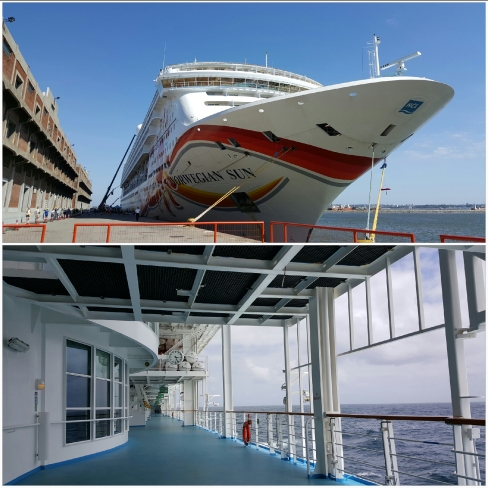
On our only previous cruise, a shorter trip to Alaska we took about five years ago, there were good musical acts and comedy troupe performances in the evenings. In this case, the acts in the theatre seemed to be desperate to kill time, and laughs were nowhere to be found. A couple musicians working on bar stages around the ship were better than the headliners, but usually not playing music to which we could relate. A trio called the Amber Strings was the best, playing classical as well as snippets from movie soundtracks.
My favorite stop was the library, which also hosted a book exchange. While there are a good number of beach reads and light lit on the shelves, I was happy to find recent award winners as well and caught up on a few that are hard to find overseas. The book exchange also yielded a couple good trades. But that seems like a cop-out after paying so much for the experience of the cruise and hoping for a wider variety of options.
I suppose this lack of activities is one reason the buffet and day-drinking were so popular. But, honestly, the buffet was only good for breakfast, and only because that meal included prepackaged cereal and yogurt so we could avoid the ‘freshly-made’ items. For lunch and dinner, the food served there was often cold and tasteless. Of course, this could be true in the sit-down dining rooms as well. Some of the dishes were clearly scraped together – I’d have warm curry surrounding already-cold rice. The chocolate volcano cake (probably the single best thing to eat on board) might arrive with a warm and still-gooey center or already resolidified and at room temperature. At one point I ordered grilled veggies, which arrived fresh-from-the-fridge cold and fresh-from-the-fridge slimy. To me, grilled implies some sort of residual heat should still be clinging to the eatables. Noticeable to our palates was a distinct lack of spice. Chorizo sauce at the tapas bar was the ONLY item we found that had any sort of spiciness whatsoever (and the guacamole there was passable as well). We debated bringing on hot sauce (tabasco doesn’t count as hot sauce, clearly), but didn’t want to sink the added expense when we knew we wouldn’t be able to bring it ashore in Chile.
Making thousands of meals each day, trying to not offend a diverse set of tastes, while working in the confines of what can be stored and cooked on a cruise ship severely limits the menu and lowers the average quality. The ceviche isn’t going to be genuine since raw fish is a health risk (one of the Peruvian staff warned us away after learning we’d been in Lima by saying we’d just be disappointed – he was right). We didn’t get norovirus or salmonella, so that at least was a plus. Worse than blandness would be being confined to a room while your one chance to see Stanley dissipates. Still, the menus were meat-heavy and seem to be centered on a steak-and-potatoes vision of a meal. That isn’t how we eat, and so much of the food felt gross to us; it all seemed to have a pervading gravy-flavored undertone (kind of how all McDonalds food tastes the same, except I actually like that one). But it was clear from eating a few times at the onboard restaurants (which cost extra) that good food can be made; we had decent duck and lamb chops, even a yummy tiramisu. The poor quality and ickily uneven temperatures in the included dining cost felt like a way to steer people toward feeling as though they had to spend more to get a decent meal.
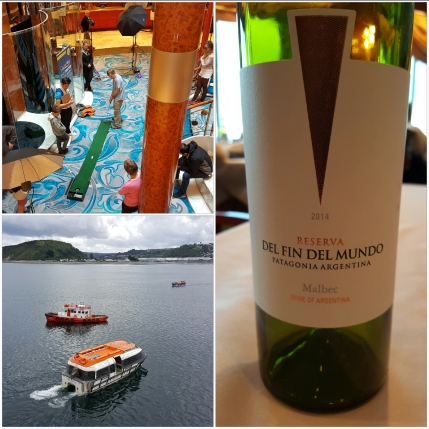
Drinking was another area where it felt like the goal was to wring every penny out of the passengers. Some people bought all-inclusive drink packages; setting themselves back about a thousand dollars each. We opted to not be lushes and simply drink sparingly. But even beer is about $8 and mixed drinks start at $10. We ordered one cocktail – a daily special – and it was simply poured out of a gallon jug rather than being made fresh. So much for value. The best deal is to buy wine for a few dollars a bottle on shore – thankfully wine in this corner of South America is a readily available bargain – and then pay $15 per bottle to bring them on the ship. Even with the high corkage fee, it was still half the cost to do this rather than order off the menus.
By the end of the cruise, I had the feeling the staff was just as annoyed at many of the shortcomings as we were. They already have a tough job – dealing with thousands of people, many though a language barrier (on both sides, the staff and many passengers speak English as a secondary language), in a service job, often thousands of miles from their homes and family, while living out of a room that is probably the size of our cabin for months at a time. That sucks. A lot. And you know that the average cruise ship employee isn’t paid a premium to compensate for these conditions. And they seem to try their hardest to work with what they are given.
Most of the lapses in service aren’t the individual employees fault – the constraints they work under put a lot out of their control. It seems to be coming in part from the overall focus on upselling and doing the bare minimum to make sure the company can say the cruise provided a particular service or event. For example, though this ship was spending months around South America, not enough Spanish-speaking staff had been hired. Naturally, this creates difficulties on both sides – passengers upset they can’t make their requests known, and staff who have a hard time understanding when the solution might be incredibly basic. To their credit, some staff members were learning Spanish and making attempts to bridge the communication gap. But trying to patch up language barriers after the fact is much harder than simply hiring or moving crew around in advance of the ship moving into a new continent.
Another instance where it seemed like the crew should have been better prepared and given more support was at ports where tender boats were needed to get to shore. Each morning before the tenders started running, I woke up early to get a numbered ticket, usually between #4 an #6. Numbers 1-5 would be called in quick succession, usually before many people were awake or ready to make use to them. Once our group was called, we would go down as soon as we could. But whether we hurried or took our time, we were often kept waiting. Everyone who had purchased tours through Norwegian got priority, and wasn’t part of their numbering system. Keep in mind the Norwegian knows how many tours they’ve sold, how many boats it will take to get those people ashore, and approximately how long that will take. But inevitably we would end up waiting in long lines of irate ticket holders while the tour groups streamed past, and the staff continued to call numbers and add to the chaos. One particular morning, the wait turned into a full hour. The tour groups being boarded before us were already late as well, meaning they knew they were behind but still kept calling more numbers. One man went up to loudly complain that this was a disturbing way to be treated and that several elderly people in line should not be standing for this long. On some later tender-port days, they did put more boats into service, seemingly to stave off complaints, and let more time pass before calling the next group. But I can’t believe they didn’t know this would be an issue. It seemed like they simply hoped that not as many people would want to tender to shore on certain days. It felt like a terrible budget airline.
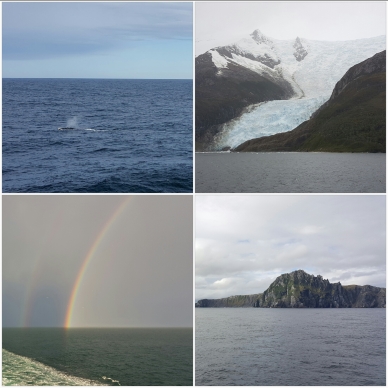
I don’t want to detract from the ports – Stanley, Ushuaia, Montevideo, and Punta Arenas are incredible places that were absolutely worth going to. But to spend 4-8 hours in a place just to see a main sight or two is not our preferred travel style. We like spending longer periods, taking in the museums, markets, local food. There were some experiences we could only have on a boat – passing by Cape Horn, spending hours whale and bird watching, seeing waves spray over top the deck when the weather worsened. But a ferry from Ushuaia to Punta Arenas or down the Chilean coast might have given us the same opportunities for less. Thankfully, we will be heading back to Punta Arenas and Montevideo in the future, and we’ll be able to get to know those places on a deeper level. Many people on board seemed to prefer to travel by cruise, and if that is what they enjoy, more power to them. But for us it is an expensive and impractical way to explore and detracts rather than adds to the sense of a place. We’ve only tried one cruise line, and I imagine others might be better and offer different experiences, but we won’t be finding out for a while.
